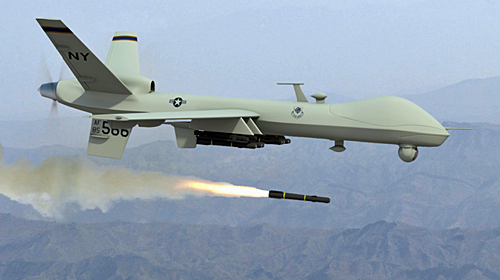
Michael Isikoff at NBC News has a Justice Department white paper that purports to explain when it would be lawful for the government to carry out the extrajudicial killing of an American citizen believed to be affiliated with a terrorist organization. Many of the white paper's arguments are familiar because Attorney General Eric Holder set them out in a in March of last year. But the white paper offers more detail, and in doing so it manages to underscore both the recklessness of the government's central claim and the deficiencies in the government's defense of it.
The 16-page white paper (read it ) is said to summarize a 50-odd page legal memo written in 2010 by the Justice Department's Office of Legal Counsel to justify the addition of U.S. citizen Anwar Al-Aulaqi to the government's "kill lists." That legal memo is one of the documents the ĄĻ°ÄĆÅæŖ½±½į¹ū is seeking in an ongoing Freedom of Information Act lawsuit. Needless to say, the white paper is not a substitute for the legal memo. But it's a pretty remarkable document.
The paper's basic contention is that the government has the authority to carry out the extrajudicial killing of an American citizen if "an informed, high-level official" deems him to present a "continuing" threat to the country. This sweeping authority is said to exist even if the threat presented isn't imminent in any ordinary sense of that word, even if the target has never been charged with a crime or informed of the allegations against him, and even if the target is not located anywhere near an actual battlefield. The white paper purports to recognize some limits on the authority it sets out, but the limits are so vague and elastic that they will be easily manipulated.
The paper initially suggests, for example, that the government's authority to use lethal force is limited to people who present "imminent" threats, but it then proceeds to redefine the word imminence in a way that deprives the word of its ordinary meaning. The paper does something similar with the phrase "capture is infeasible." It initially sounds like a real limitation but by page 8 it seems to mean only that the government won't use lethal force if capture is more convenient. It's the language of limitsābut without any real restrictions.
Even more problematic, the paper contends that the limits on the government's claimed authority are not enforceable in any court. ("There exists no appropriate judicial forum to evaluate these constitutional considerations.") According to the white paper, the government has the authority to carry out targeted killings of U.S. citizens without presenting evidence to a judge before the fact or after, and indeed without even acknowledging to the courts or to the public that the authority has been exercised. Without saying so explicitly, the government claims the authority to kill American terrorism suspects in secret.
Some of the white paper's key legal arguments don't stand up to even cursory review. The paper omits crucial language from Mathews v. Eldridge, a case in which the Supreme Court held that the question of what process must be afforded to a person before he is deprived of life or liberty must take into account "the risk of an erroneous deprivation of such interest through the procedures used, and the probable value, if any, of additional or substitute procedural safeguards." The white paper skips over this language, . While the white paper does acknowledge "the risk of erroneous deprivation of a citizen's life," it doesn't grapple with the possibility of additional procedural safeguards. And when the white paper dismisses the possibility of judicial review, it does so in a single paragraph that fails even to acknowledge the possibility of after-the-fact judicial review of the kind that our courts routinely provide in .
(Incidentally, this after-the-fact judicial review is what the ĄĻ°ÄĆÅæŖ½±½į¹ū and CCR are seeking in Al-Aulaqi v. Panetta, a case now pending before the district court in D.C. We'll be filing our principal brief in that case tomorrow).
The white paper also suggests, incorrectly, that the courts have endorsed the view that there is no geographic limitation on the government's exercise of war powers. In fact all of the cases in which the D.C. Circuit has upheld the detention of a prisoner held at Guantanamo involved a connection of some kind to Afghanistan. And, more important, the Supreme Court case on which the white paper relies most heavily involved an American who was detained in Afghanistan. You can't reasonably read a case that permitted the military detention of an American on an actual battlefield to supply a green light for the extrajudicial killing of American terrorism suspects anywhere in the world.
Finally, the white paper assumes a key conclusion: It takes as a given that the target of the strike will be a "senior operational leader of al-Qa'ida or an associated force of al-Qa'ida," and it reasons from that premise that judicial process is unnecessary. This is a little bit like assuming that the defendant is guilty and then asking whether it's useful to have a trial. Perhaps the white paper omits analysis that appears in the Justice Department's legal memos, but again the legal memos are, inexcusably, .
My colleagues will have more to say about the white paper soon, but my initial reaction is that the paper only underscores the irresponsible extravagance of the government's central claim. Even if the Obama administration is convinced of its own fundamental trustworthiness, the power this white paper sets out will be available to every future presidentāand every "informed high-level official" (!)āin every future conflict. As I , that's truly a chilling thought.
Learn more about targeted killings and other civil liberty issues: Sign up for breaking news alerts, , and .

